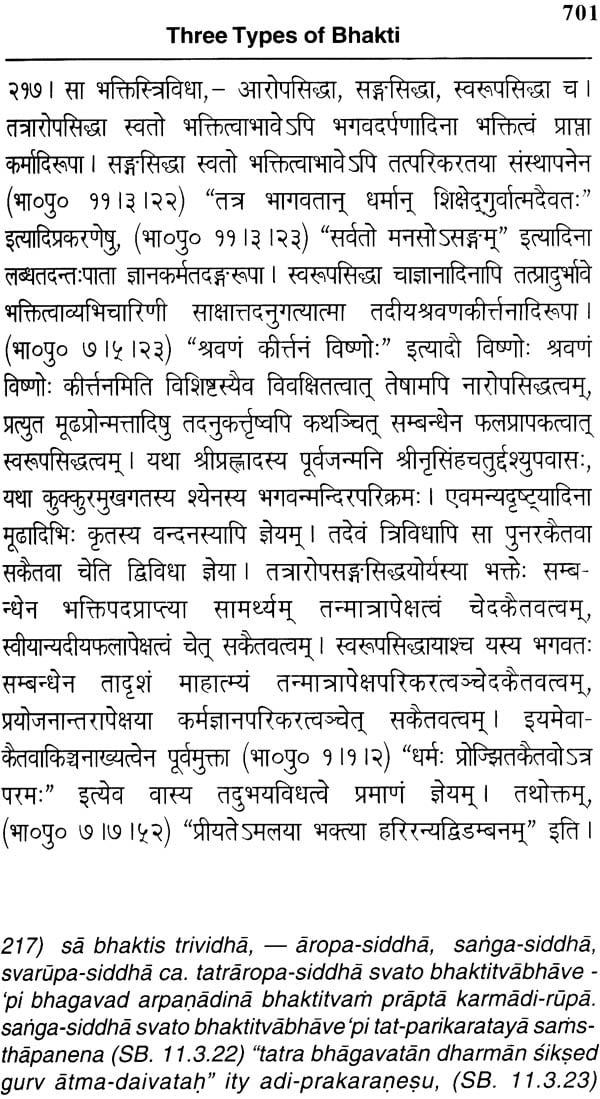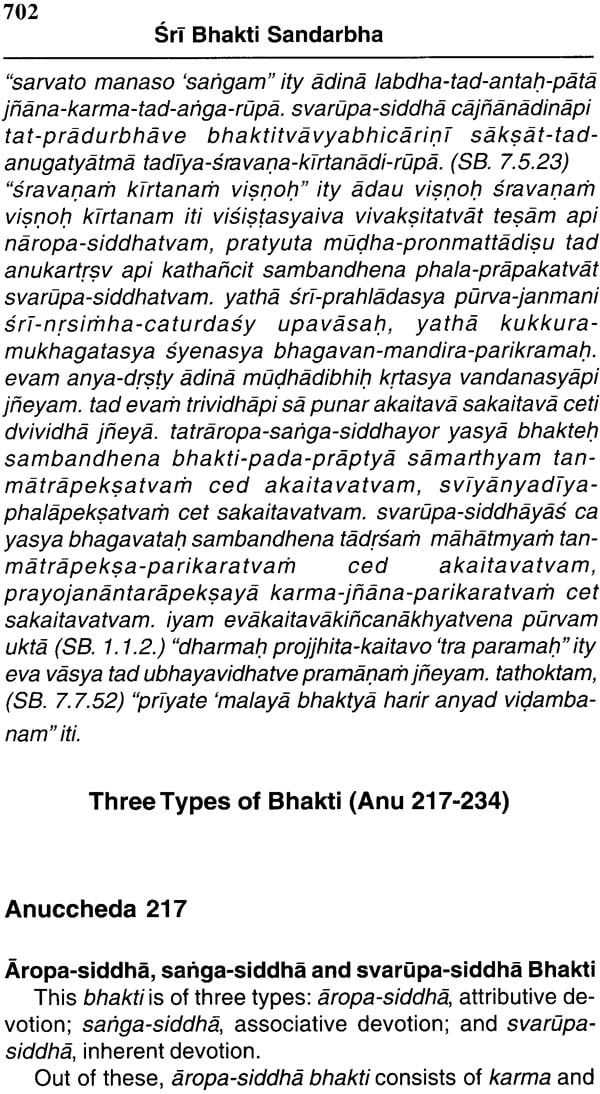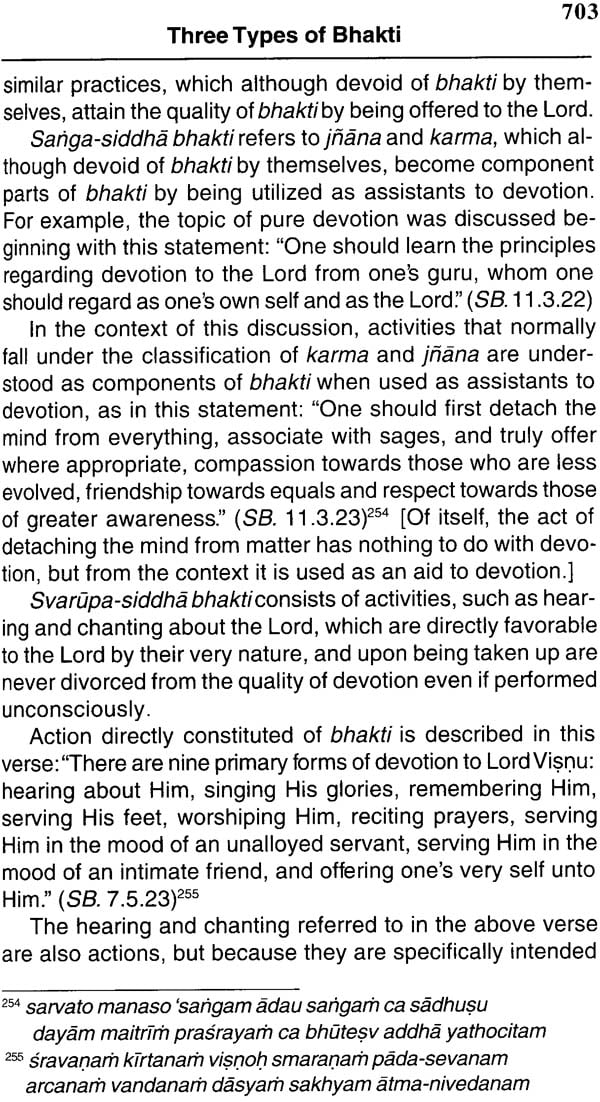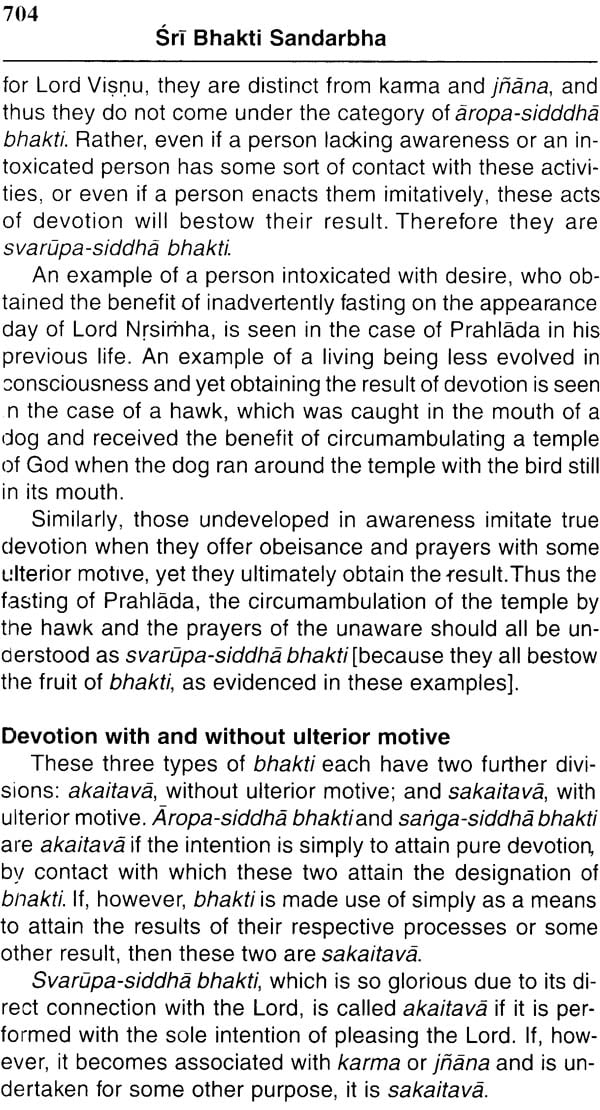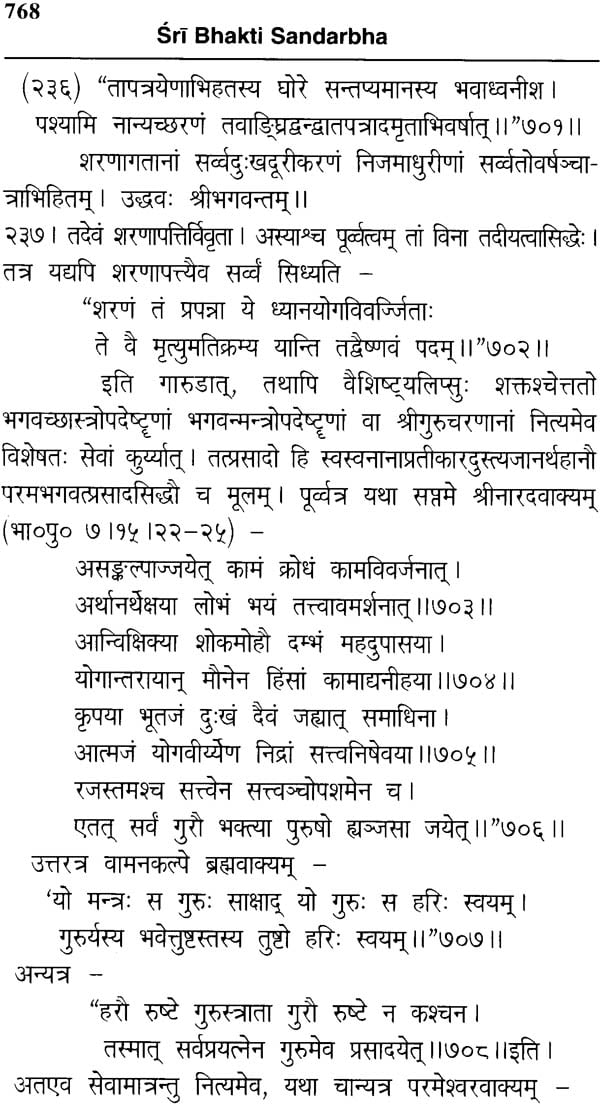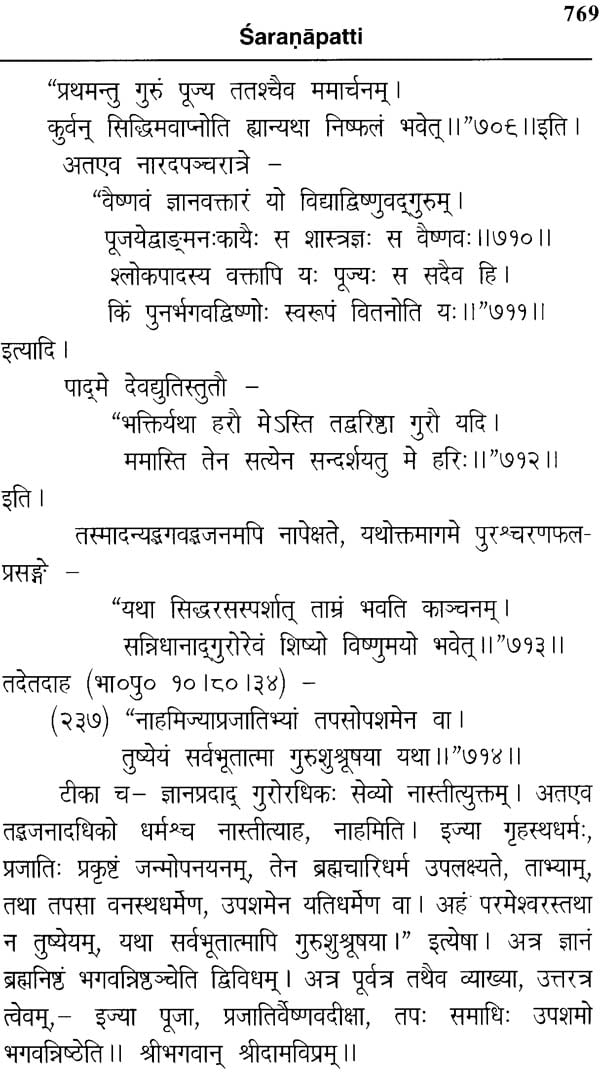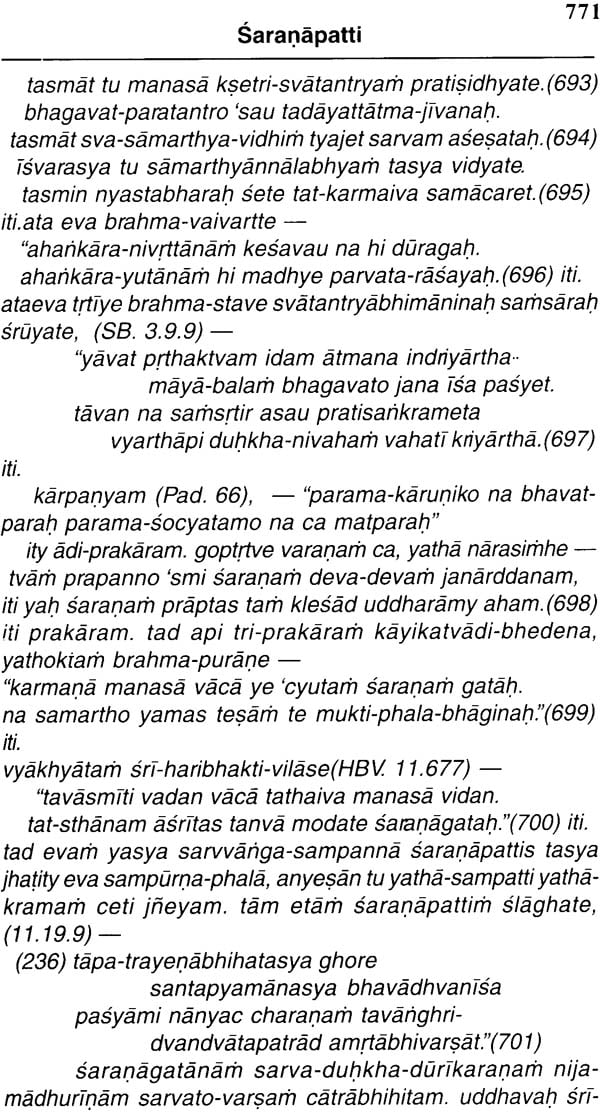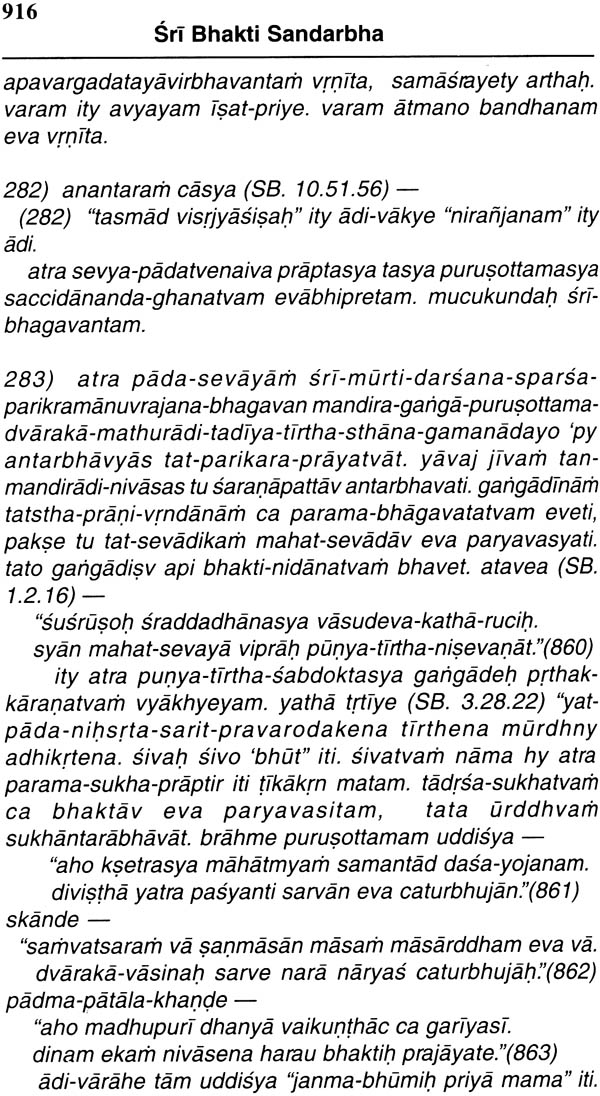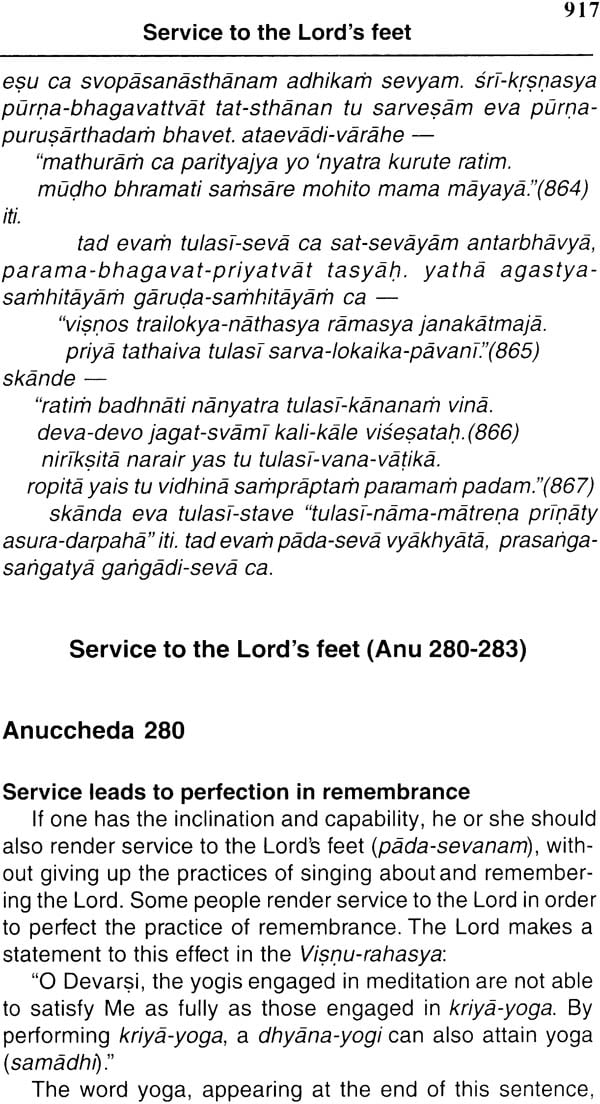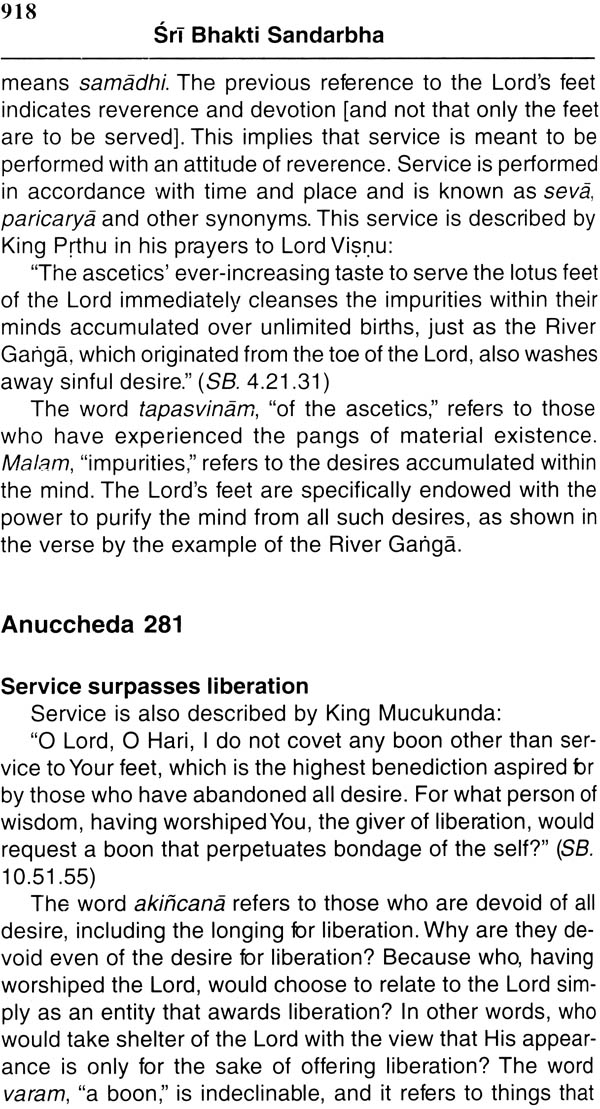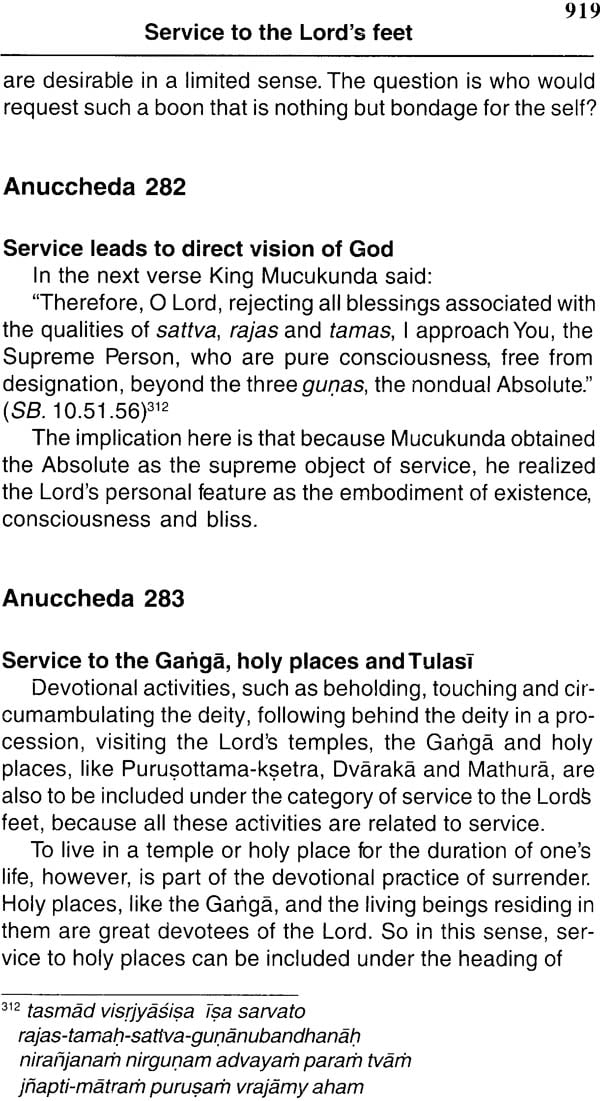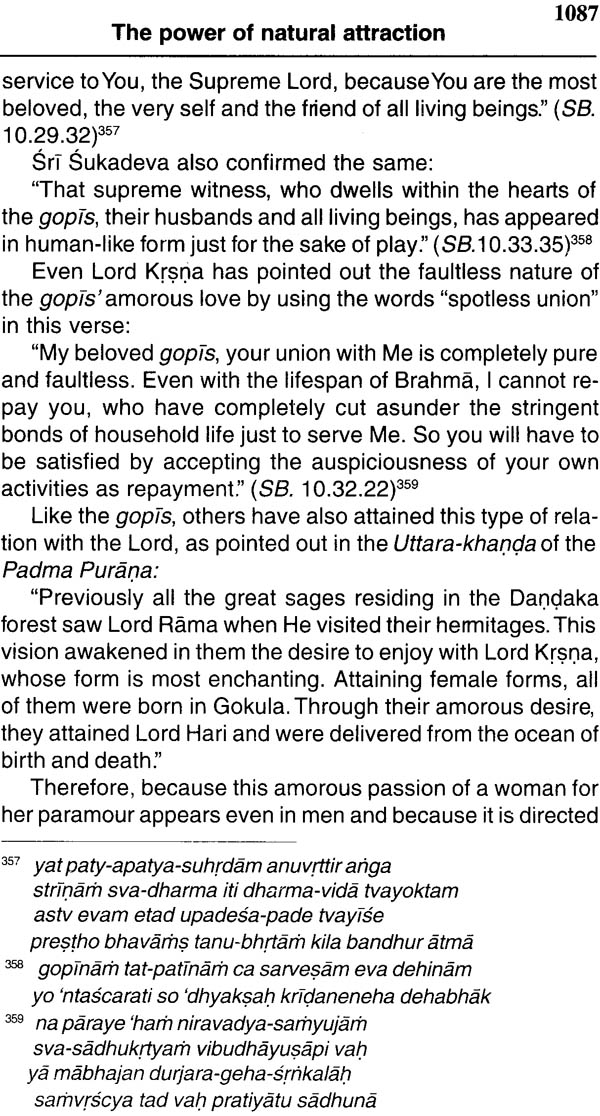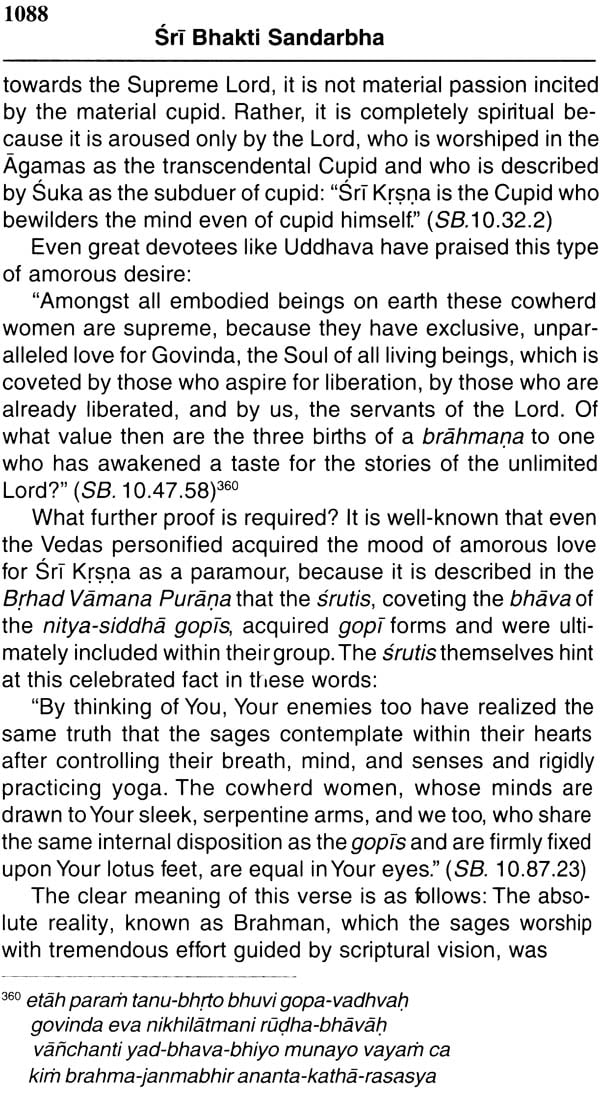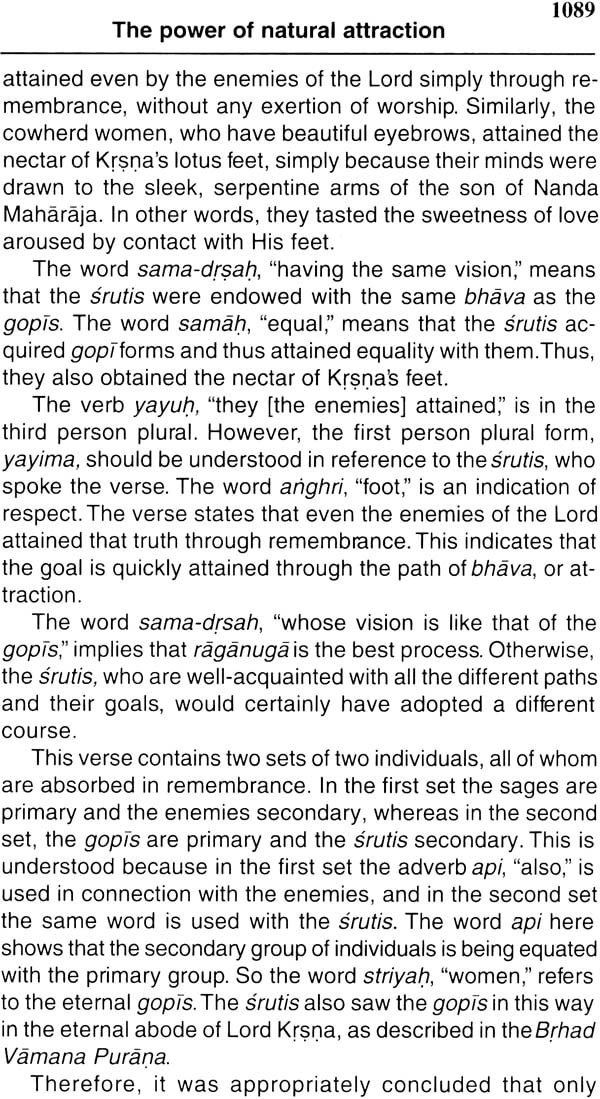
Sri Bhakti Sandarbha (Volume 3) The Fifth Book of The Sri Bhagavata-Sandarbhah Also Known as Sri Sat-Sandarbhah By Srila Jiva Gosvami Prabhupada ( (Sanskrit Text, Roman Transliteration and English Translation))
Book Specification
| Item Code: | IDI703 |
| Author: | Dr. Satya Narayana Dasa and Bruce Martin |
| Publisher: | Jiva Institute, Vrindavan |
| Language: | (Sanskrit Text, Roman Transliteration and English Translation) |
| Edition: | 2006 |
| ISBN: | 8187153784 |
| Pages: | 725 |
| Cover: | Hardcover |
| Other Details | 8.8" X 5.7 |
| Weight | 850 gm |
Book Description
From The Jacket
Bhakti Sandarbha is the fifth book of the Six Sandarbhas. It offers a thorough analysis of Bhakti, or devotion, on the basis of Srimad Bhagavatam. Jiva Gosvami states that the Bhagavatam prescribes Bhakti as the most efficacious and universal process (abhidheya) for realizing the absolute. Bhakti has never been established as abhidheya so systematically and emphatically as in this book. Earlier Bhakti was generally considered as one among various spiritual processes. Including karma-yoga, jnana-yoga and Astanga-yoga. moreover it was usually regarded as a precursor to jnana, which ultimately leads to liberation. Rarely was Bhakti viewed as an independent process. In contrast to this. Jiva Gosvami asserts that Bhakti is the complete abhidheya, and as such all other processes become futile when bereft of devotion. Other practices have enduring significance only through contact with devotion. Even realization of Brahman is possible only by the grace of bhakti. Bhakti is the most blissful process both in practice and in perfection.
Dr. Satya Narayana Dasa earned his graduate degrees, B. Tech. & M. Tech. In engineering, from IIT Delhi, and worked as a software engineer in USA for a few years.
He gave up a promising career in this field to pursue the inner quest for truth. He studied Sanskrit and the six systems of Indian philosophy under various traditional Gurus in Vrndavana. He also studied the entire range of Gaudiya Vaisnava literature from his Guru. Sri Haridas Sastri. One of the eminent scholars and saints of India.
Dr. Satya Narayana Dasa (PhD. Sanskrit) founded Jiva Institute to promote Vedic culture, philosophy and Ayurveda through education. He regularly gives classes on Gaudiya Vaisnava literature and has authored many books on the subject. He has contributed to the twenty-five volume work brought out by the project of history of Indian science, philosophy and culture.
Bruce Martin has been studying the systems of Indian philosophy. Especially tha of the Chaitanya School for over twenty-five years. Besides English, he is conversant in French, Sanskrit, and Hindi. He has translated and edited several Vaisnava works, including Bhagavad-gita, Bhakti-rasamrta-sindhu-bindu, Siksastaka and Manah-siksa.. He is well read in both modern and traditional systems of phi8losophy and is particularly concerned with bringing out the relevance of ancient wisdom tradition for modern practitioners.
Back Of The Book
This devotion of the Lord's associates, expressed in the form of hearing and so on, is itself sadhya, the state of perfection, because these actions arise like waves in the Ganga of devotion that is permeated by love in its perfectional state (sadhya-raga-bhakti). As such, the hearing and chanting of the Lord's associates [known as ragatmika-bhakti] does not come under the heading of sadhana, the practice of devotion.
For this reason we will now discuss discuss raganuga-bhakti, the practice of devotion following in the wake of the moods of natural affection. When a person develops a taste for the aforesaid specific raga, even though that raga itself has not yet arisen in her or him, the heart becomes like a crystal, shining as it reflects the rays of the mo on of that raga. By hearing about this raga from scripture of from one's teacher, one develops a taste for the actions of the ragatmika associates also that are expressions of this ragatmika bhakti. Then by adhering to the raga of a particular associate of the Lord according to one's taste, one executes devotion, which is called raganuga.
In the first two volumes we presented parts one and two of Bhakti Sandarbha, "Bhakti is the Complete Methodology;' and, "The Preeminence of the Lord's Devotees." In volume one Jiva Gosvami defined the methodology to realize the Absolute in basic terms, as sammukhye, turning one's gaze to encounter the divine. He then offered objective criteria to assess what characterizes a complete methodology. In ev- ery instance, Jiva showed that bhakti alone meets the crite- ria of completeness.
So after authoritatively establishing bhakti as the supreme method throughout the first volume, Jiva ends with the sur- prising disclosure that bhakti is in fact not a method at all in the sense of generating something separate from itself, thus reconfirming its complete nature. Bhakti is a self-manifest, spontaneous flow of divine potency. As long as this flow re- mains unmanifest within the aspirant, the practices outlined on the path of devotion remain preparatory, seeking an open- ing within the heart of the practitioner whereby bhakti can infuse the consciousness with full awareness of the divine and the bliss of direct communion through love.
This naturally brings up the question, where does this flow originate? This is discussed in volume two. The sages im- mersed in devotion are said to be the transmitters of the po- tency of devotion and independent in the distribution of mercy. Thus devotion is received from them.This confirms that bhakti is a phenomena that descends directly from the spiritual plane, permeating and transforming the individual consciousness. Being an aspect of the internal potency, bhakti does not emerge from the constitution of the soul, which has already been stated to be the intermediary potency, distinct from the internal and external potencies. The living beings, who are conscious by nature and etemal parts of the complete whole are perfectly suited, however, as receptacles of the elixir of devotion, which allows for the highest integration of their be- ing.
Since devotion flows from the sage, the entire path con- sists of emptying oneself of all misidentification to create a total opening, whereby the awareness of the sage can per- meate one's being, thus establishing the eternal flow of devo- tion within the individual soul. For this reason, Jiva has clearly defined the characteristics of the neophyte, intermediate and superlative devotees, with particular emphasis on the latter, to help the aspirant identify the proper source from which this flow can be received. Simultaneously, the depth of the devotee's vision, who has captivated the Absolute through love, clearly demonstrates that the receptacle of devotion is as complete as bhakti itself.
After providing the foundational understanding of devo- tion and devotees in the first two parts respectively, Jiva discusses the practices of devotion in this volume, "Direct Centering of Awareness through Worship," (Anu 214-340). This volume is divided into five chapters: "Awareness in the Form of Direct Worship" (Anu 214-216), " Three Types of Bhakti" (Anu 217-234), "VaidhT Bhakti " (Anu 235-310), "Raganuga Bhakti" (Anu 310-338), and the conclusion (Anu 339-340).
The first chapter offers a brief introduction to the subject of direct worship as well as defining the intrinsic and extrin- sic nature of bhakti. In Anu 214 Jiva states that the stages of the path discussed in Anu 202-213 of the previous volume, beginning from initial liking up to the point of taking shelter of a guru, are preliminary to the actual stage of worship Thus he begins a new section to discuss his original concept of sammuknye in terms of direct worship.
This shift in awareness can be of two types: that related tq the unqualified Absolute and that related to the Absolute with attributes. The first type refers to jnana, or nondual aware- ness. The second is divided into ahangrahopasana, or wor- ship of oneself as embodying the divine, and bhakti, or devo- tion to the complete whole.
The methods on the path of jnana include hearing and de- liberation on scriptural truth, as well as meditation, involving an implosion of the gross elements into the subtle, leading finally to mergence in Brahman. Ahangrahopasana involves meditation on oneself as embodying the divine, by which the potencies of God become manifest in the practitioner.
In Anu 216 Jiva Gosvami defines the intrinsic and extrin- sic nature of devotion. The intrinsic character of a methodol- ogy refers to that which is inseparable from its nature, that of which it is constituted, whereas the extrinsic character re- lates to that which comes about as a result of the practice. Jiva pinpoints the very essence of bhakti in a single word, as seva, which he defines as loving responsiveness to the Lord with the faculties of body, mind and speech.
The extrinsic character of devotion relates to the fact that it can bestow everything possible, up to complete realization of the Absolute in its three prominent manifestations of Brah- man, Paramatma and Bhagavan. In chapters three and four Jiva will elaborate on the concept of seva, showing various divisions of vaidhi and raganuga bhakti.
In chapter two (Anu 217-234) Jiva describes three types of bhakti: attributive (aropa-siddha), associative (sanga- siddha) and inherent (svarupa-siddha), as well as devotion influenced by the three qualitative constituents of nature. In reality, pure devotion is nothing other than svarupa-siddha bhakti. The other varieties are discussed just to clarify what is meant by pure devotion. These three types of bhakti may also be classified as sakaitava, with ulterior motive, and akaitava, without ulterior motive, or in other words, with the sole intent of attaining pure devotion. This chapter provides the basis for a discussion of the practices of devotion found in the next two chapters.
In the first section of chapter two ( Anu 217-224), Jiva discusses aropa-siddha bhakti, or action indirectly attributed with the quality of devotion. This refers specifically to the of- fering of karma, which includes both temporal action and du- ties prescribed in scripture. In attributive devotion the per- former remains distinct from the offering, because the self remains unoffered. It is this sense of separateness from the Absolute, from the entity who receives the offering, that is the basis of the performer's identification with prescribed duty. Without the sense of separateness no offering is possible, because who will offer and who will receive?
In pure devotion, however, the individual being is offered from the very outset and hence there is no need, and in fact no possibility, of offering anything else separately. When the concept of separateness from the whole is broken, all facul- ties of the being naturally flow to the entity in whom the self is offered. Thus the intrinsic character of bhakti has been de- fined as seva, divine service arising out of the communion of love, and not arpanam, an offering of the peripheral move- ment of the being. The act of offering, however, is attributed with the quality of devotion because of being directed towards the Lord. Thus it is known as attributive devotion..
In this section Jiva shows that both temporal action im- pelled by one's nature and the socio-religious duties outlined in scripture (Vedic karma) both come under the heading of attributive devotion when offered to the Lord. Thus even the offering of temporal action can become a gateway to devo- tion. Jiva goes as far as saying that even unwholesome deeds should be offered to the Lord, especially for those fraught with material desire. This is not a license to indulge in unwholesome deeds but rather an avenue whereby the per- former can connect everything without exclusion to the whole, and through the purification that results through this intent, the unwholesome will be released of its own accord.
This understanding is of essential importance to modern practitioners who are not suited to live in a temple, asrama or holy place, or to engage exclusively in prescribed acts of devotion. The division of life into material and spiritual cre- ates a sense of disconnection from the divine, wherein, only those acts specifically designated as worship are seen to nurture connectedness, whereas the remainder, encompass- ing all normal functions of human life, becomes a source of disconnection.
So, rather than integration of the self into the whole, the individual becomes a collectivity of opposing forces and ex- periences only division. Jiva does not support this type of divergence. Rather, by bringing one's entire being to the altar of sacrifice, excluding nothing, the connectedness established thereby fills the being, creating an opening for the unobstructed flow of devotion.
If even the offering of temporal action is beneficial, then the offering of prescribed religious duties (Vedic karma) is certainly so. At this point Jiva raises an interesting question: Since karma is the cause of material bondage, how can the same karma become the cause of liberation? Jiva answers that it can do so because the offering to the Lord empowers karma with a medicinal effect that can eradicate the original cause of the disease.
This leads into a discussion about the result of offering karma as it relates to the path known as karma-mimamsa, which concerns itself chiefly with the proper execution of Vedic rituals. Jiva raises the question that since the correct perfor- mance of Vedic karma generates a corresponding result that will manifest only at some point in the future, where does this intangible result reside in the interim?
The mimamsakas claim that this intangible result lies ei- ther within the performer or within the devas who administer the results of sacrifice. Both ideas, however, reinforce the sense of separateness from the whole, referred to above, and hence the result achieved by such a performer is not only limited but perpetuates the state of bondage.
| Abbreviations | ix |
| Abbreviations (Devanagari) | xi |
| Introduction | xix |
| | |
| | |
| Anu 214 Two types of direct awareness | 691 |
| Anu 215-216 Sadhana on the path of jnana | 692 |
| Anu 216 Ahangrahopasana sadhana | 694 |
| Intrinsic and extrinsic nature of devotion | 694 |
| | |
| | |
| Anu 217 Aropa-siddha, sanga-siddha and Svarupa- siddha Bhakti | 702 |
| Devotion with and without ulterior motive | 704 |
| Aropa-siddha Bhakti (Anu 217-224) | 717 |
| Anu 217 The offering of temporal action | 717 |
| Anu 218 The benefit of offering Vedic karma | 721 |
| Anu 219-221 The medicinal nature of offering karma | 722 |
| Anu 222 The result of karma is sheltered in the Lord | 723 |
| Anu 223 How the offering of karma leads to bhakti | 727 |
| Anu 224 Two ways of offering karma | 728 |
| Three motives impelling karma | 729 |
| Sanga-siddha Bhakti (Anu 225-230) | 738 |
| Anu 225 Three types of karma-misra bhakti | 738 |
| Sakama (mixed with karma alone) | 738 |
| Anu 226 Kaivalya-kama (mixed with karma and jnana) | 740 |
| Anu 227 Kaivalya-kama (mixed with jnana alone) | 741 |
| Anu 228 Bhakti-matra-kama (mixed with karma alone) | 741 |
| Anu 229 Bhakti-bhakti-matra-kama (mixed with karma and jnana) | 742 |
| Anu 230 Bhakti-matra-kama (mixed with jnana alone) | 744 |
| Influence of the three qualities on the path of inherent devotion (Anu 231-233) | 747 |
| Anu 231 Influence of darkness | 747 |
| Anu 232 Influence of passion | 748 |
| Anu 233 Influence of goodness | 748 |
| Svarupa-siddha Bhakti (Anu 34) | 754 |
| Anu 234 The causeless, unobstructed flow of devotion. | 754 |
| Bhakti is nirguna | 756 |
| Bhakti is ultimate liberation | 756 |
| Devotion accommodates infinite variety | 758 |
| Exclusive dedication to the Lord | 758 |
| | |
| | |
| Anu 235 Vaidhi bhakti impelled by two types of injunctions | 764 |
| Saranapatti (Anu 236-237) | 773 |
| Anu 236 Devoid of other shelter | 774 |
| Six symptoms of surrender | 775 |
| Anu 237 Surrender to guru | 777 |
| Removal of obstacles | 778 |
| Devotion to guru embodies all devotion | 778 |
| Service to devotees who embody truth (Anu 238-247) | 800 |
| Anu 238 Taking permission of one's guru | 800 |
| Rejection of non-Vaisnava guru | 801 |
| Association of appropriate devotees | 801 |
| The effect of association with devotees (Anu 238-243) | |
| Anu 238 Association of devotees not reliant on other means. | 802 |
| Regular devotional duties not preempted by such association | 805 |
| Anu 239 Captivation of the Lord through association with true devotees | 806 |
| Primary influence bestows prema | 807 |
| Anu 240 Association of devotees not dependent on any spiritual discipline | 810 |
| Anu 241 Primary influence achieved only by sat-sanga | 811 |
| Anu 242 Love is attained only through sat-sanga | 812 |
| Anu 243 Association effective even where awareness is lacking | 813 |
| The effect of service to devotees (Anu 244-247) | |
| Anu 244 The result of service to devotees surpasses everything | 814 |
| Anu 245 The defect of non-service to true devotees | 815 |
| Anu 246 Transcendence of temporal existence through service to devotees | 817 |
| Anu 247 All Vaisnavas are honorable | 818 |
| Vaisnavas transcend caste considerations | 818 |
| Vaisnavas are honorable, not honor-driven | 819 |
| Vaisnava's behaviour not to be judged | 820 |
| Service to devotees precedes all, bestows all auspiciousness | 821 |
| Hearing about the Lord (Anu 248-262) | 837 |
| Anu 248 Hearing the Lord's name | 837 |
| Anu 249 Hearing of the Lord's form | 838 |
| Anu 250 Hearing o the Lord's qualities | 839 |
| Anu 251 Hearing leads to realization of the Lord | 841 |
| Anu 252 The defect of not hearing about the Lord | 841 |
| Anu 253 Hearing the Lord's pastimes | 843 |
| Anu 254 Two types of pastimes | 844 |
| Anu 255 Praise of the Lord's pastimes | 845 |
| Anu 256 Recommended order of hearing | 847 |
| Anu 256-257 Hearing from elevated devotees | 847 |
| Anu 258-259 Hearing from elevated devotees | 847 |
| Anu 260 The influence of hearing Srimad-Bhagavatam. | 850 |
| Anu 261 The relish of Srimad-Bhagavatam | 851 |
| Anu 262 Optimization of hearing | 851 |
| Singing about the Lord (Anu 262-275) | 878 |
| Anu 262 Singing the names of the Lord | 878 |
| Anu 263 Primary result of singing the name | 878 |
| Omnipotence of singing the name | 880 |
| Anu 264 Glories of singing the name | 881 |
| Anu 265 Singing the names-the peerless method for all | 882 |
| Ten offences to the name | 883 |
| Anu 266 Singing about the forms of the Lord | 891 |
| Anu 267 Singing the virtues of the Lord | 892 |
| Anu 268 Singing the pastimes of the Lord | 892 |
| Anu 269 Speech about the Lord is real | 893 |
| Anu 270-271 Kirtana recommended for the age of kali | 895 |
| Anu 272 The glory of kirtana | 896 |
| Anu 273 The benefit of Kali-yuga | 897 |
| Kirtana transcends time and place | 898 |
| The superiority of kirtana | 899 |
| Anu 274 Heretics remain indifferent to the Lord | 900 |
| Anu 275 Singing of the Lord from the Bhagavata | 901 |
| Remembrance (Anu 275-279) | 906 |
| Anu 280 Service leads to perfection in remembrance | 917 |
| Anu 281 Service surpasses liberation | 918 |
| Anu 282 Service leads to direct vision of God | 919 |
| Anu 283 Service to the Ganga, holy places and Tulasi | 919 |
| Worship (Anu 283-303) | 964 |
| Anu 283 Arcana and diksa | 964 |
| Arcana recommended for householders | 965 |
| Considerations regarding worship | 966 |
| Anu 284 Nama and mantra | 968 |
| Pure and mixed worship | 970 |
| Anu 285 Two ways of performing karma as worship | 971 |
| Transcendent and temporal forms of | |
| Durga and Ganesa | 972 |
| Anu 286 Refinement of mixed worship | 975 |
| Bhuta-suddhi and nyasa | 978 |
| Guidelines for internal worship | 980 |
| Seats of worship (Anu 286-295) | |
| Anu 286 Salagrama, Mathura and other holy places | 981 |
| The deity is non-different from the Lord | 982 |
| Worthiness to receive worship | 984 |
| Anu 286-288 Supreme worthiness of Krsna | 985 |
| Anu 289 Worthiness of human beings | 986 |
| Anu 290-291 Worthiness of the deity | 987 |
| Anu 292-293 Worthiness of the brahmana | 988 |
| Anu 294 Worthiness of the jnani | 989 |
| Anu 295 Other receptacles of worship | 991 |
| Two approaches to worship (Anu 296-297) | |
| Anu 296 Worship of the receptacle of the Lord | 992 |
| Worship of the Lord directly | 993 |
| Appropriate use of mantras and offerings in worship | 994 |
| Anu 296-297 The result of the direct worship | 995 |
| Anu 298 Eligibility for worship | 996 |
| Anu 299 Other practices within arcana | 997 |
| Observance of Janmastami and Kartika | 998 |
| Ekadasi | 998 |
| Observance of Magha | 1001 |
| Offences in worship (Anu 300-303) | |
| Anu 300 Avoiding the 32 offences in worship | 1002 |
| Anu 301-302 Avoiding offences to devotees | 1003 |
| Anu 303 Redemption from offences | 1004 |
| Offering Obeisance (Anu 303) | 1008 |
| Anu 303 General description of vandana | 1008 |
| Servitorship (Anu 304-305) | 1012 |
| Anu 304 General description of dasyam | 1012 |
| Anu 305 Service enhanced by the attitude of servitorship | 1013 |
| Friendship (Anu 306-308) | 1017 |
| Anu 306 Friendship surpasses servitorship | 1017 |
| Anu 307-308 The outcome of friendship with the Lord | 1019 |
| Self-surrender (Anu 309) | 1024 |
| Anu 309 General description of atma-nivedanam | 1024 |
| Various types of self-surrender | 1025 |
| Complete self-surrender of Ambarisa | 1025 |
| Self-surrender with and without a specific relation of love | 1028 |
| Anu 310 Emphasis of specific limbs of devotion | 1028 |
| | |
| | |
| General description of raganuga (Anu 310-312) | 1044 |
| Anu 310 The meaning of raga and ragatmika bhakti | 1044 |
| Adhering to the raga of the Lord's eternal associates | 1045 |
| Raganuga more powerful than vaidhi | 1046 |
| Taste in ragatmika bhakti | 1047 |
| Anu 311 Raganuga in the mood of a consort of the Lord | 1048 |
| Anu 312 Raganuga in the moods of servitorship and parental affection | 1049 |
| Raganuga is not dependent on injunctions | 1050 |
| Raganuga mixed with vaidhi | 1053 |
| Transgression of injunctions in raganuga | 1054 |
| The power of natural attraction (Anu 312-324) | 1076 |
| Anu 312-314 Sisupala's blasphemy of Krsna | 1076 |
| Anu 315 Criticism relates to the material body | 1077 |
| Anu 316 God is beyond the range of criticism | 1078 |
| Anu 317 Absorption by whatever means | 1079 |
| Anu 318 Absorption even through enmity surpasses vaidhi. | 1080 |
| Anu 319 The power of absorption | 1080 |
| Anu 320 Attaining the Lord through amorous love | 1081 |
| Passion is distinct from enmity and fear | 1082 |
| Amorous love is an inherent feature of the Lord's lila | 1085 |
| Amorous love supported in scripture | 1086 |
| Anu 321 five attitudes of absorption in the Lord | 1090 |
| Anu 322 Enmity is not part of bhagavat-dharma | 1092 |
| Anu 323 Devotion through raga is the most effective path of absorption | 1093 |
| Anu 324 Raganuga bhakti is the recommended path | 1094 |
| Enmity is not included in devotion | 1094 |
| The most confidential wisdom (Anu 325-338) | 1116 |
| Anu 325 Raganuga is primarily for Sri Krsna | 1116 |
| Submission to love is Krsna's ultimate supremacy | 1117 |
| Preeminence of raganuga for Krsna in Gokula | 1121 |
| Anu 326 Rejection of jnana and yoga | 1123 |
| Anu 327 Krsna submits to the love of His devotees | 1124 |
| Anu 328 Non-possibility of abandoning supreme mercy | 1126 |
| Anu 329 The devotee's eternal indebtedness to the Lord | 1128 |
| Anu 330 Devotion to Krsna is supreme dharma | 1129 |
| Anu 331-332 Devotion to Krsna: The most confidential wisdom | 1130 |
| Anu 333 Supremacy of devotion to Sri Krsna | 1134 |
| Anu 334-336 Exclusive devotion to the complete form of Sri Krsna | 1135 |
| Anu 337 Supreme mercy found in Krsna alone | 1137 |
| Anu 338 Supremacy of devotion to Krsna in Gokula | 1137 |
| Supremacy of rasa-lila | 1138 |
| Supremacy of devotion to Radha-Krsna lila | 1138 |
| | |
| Anu 339 The confidentiality of realization | 1146 |
| Anu 340 Progressive stages in devotion | 1147 |
